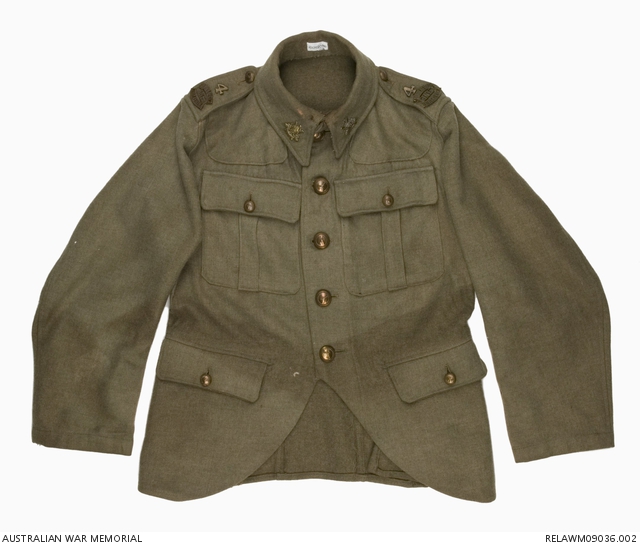| Places | |
|---|---|
| Accession Number | RELAWM09036.002 |
| Collection type | Heraldry |
| Object type | Uniform |
| Physical description | Wool twill; Brass; Cotton |
| Maker |
Unknown |
| Place made | United Kingdom |
| Date made | c 1914-1918 |
| Conflict |
First World War, 1914-1918 |
Other rank's khaki doublet : Private F A Henley, 4th South African Infantry Battalion, South African Expeditionary Force

4th South African (Scottish) Infantry Battalion other rank's khaki wool doublet with a stand and fall collar, pleated breast pockets with plain rectangular flaps, and inset pockets, with the same flaps, below the front waist. The front skirts of the doublet are cut away in style adopted by all Scottish units. Each shoulder has an additional patch of khaki fabric attached to prevent wear from the leather equipment that was worn. The brass collar badges feature the Scottish lion within a shield that is superimposed on the Cross of St Andrew and a thistle wreath. Above these elements is a hand clutching an arrow, and below it in a scroll is the motto 'MORS / LUCRUM / MINI'. A brass numeral '4', and shoulder title 'SOUTH AFRICA / INF / ZUID AFRIKA', are attached to both of the shoulder straps. Although this battalion generally wore a specific battalion button with the same design as the collar badge, all of those on it are of the South African general service pattern which show the head of a springbok. A British War Department acceptance mark '126 / W^D / M' is stamped in black on the white cotton fabric inside the jacket, which has been used to reinforce the area from below the right armpit to the belt hook on that side.
Worn by 16899 Private Frank Archibald Henley, 4th South African (Scottish) Infantry, South African Expeditionary Force. He served on the Western Front and was taken prisoner of war by the Germans in April 1918 who took most of his original kit. He was presumably issued with this uniform on his release. In a letter dated 4 November 1938, in response to questions from AWM staff about his unit's uniform, Private Henley provided the following details, 'No sporran was worn during active service, not officially issued; khaki aprons were only issued in France to protect from mud [he was not re-issued with one when he was released]; If I remember rightly we wore leather equipment, walking out dress would be as you state belt, bayonet frog, but no bayonet, unless on picket duty; swagger cane was optional but usually used; As far as my memory serves me after all the years, the equipment was leather belt, shoulder straps, with webbing haversack, valise: bayonet frog and entrenching tool case, I think but would not be sure on this point were also leather, as were the ammunition pouches; The position of hose tops & ankle puttees were the same as Imperial Scottish Regiments'. With regard to the title of his unit he wrote, 'Either title would be correct. South Africa only had one Brigade, 1st, 2nd, 3rd wore ordinary uniforms & the 4th kilts, sometimes we were addressed as 4th S.A. Infantry & sometimes S.A. Scottish, altho (sic) the latter, I think was more commonly used'.